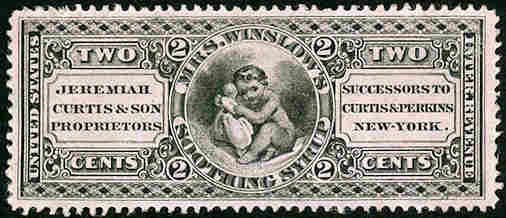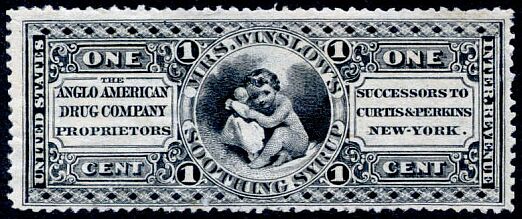

Jeremiah Curtis & Son
Anglo-American Drug Company


The flagship product of Jeremiah Curtis & Son was Mrs. Winslow's Soothing Syrup, which was first marketed in 1835. It contained a small amount of morphine, and was said to cure all diseases of children. The product was so well known that a movement in a divertimento by Sir Edward Elgar was titled after the remedy. One-cent private die stamps for the company were first issued in February of 1863 and last in 1880. 2,862,188 were issued on old paper and 2,090,000 on watermarked paper.
Printing was discontinued in November of 1865 and resumed in 1878. The die was re-engraved for the second period of printing. The printings can be told apart both by paper types and by the smaller numerals of the first die.

The two-cent stamp was issued from September of 1864 until some time late in 1879. 13,569,316 were printed on old paper, 5,827,340 on silk paper, and 2,435,369 on pink and watermarked papers. This copy is on pink paper.
In 1865 Jeremiah Curtis & Son formed a limited partnership, Curtis & Brown, with John I. Brown & Son to market certain nostrums, not including Mrs. Winslow's Soothing Syrup. A "receipt book" of 1872 shows the interaction of the companies.

In 1880 the Anglo-American Drug Company, headed by George N. Curtis, the son of Jeremiah Curtis, assumed marketing of that product, and the one-cent private die stamps were altered accordingly. 3,764,000 were issued on watermarked paper beginning January 17, 1881 and ending with the delivery on March 26, 1883.

A card proof of the original die of the Jeremiah Curtis & Son one cent stamp.

An advertising card for Mrs. Winslow's Soothing Syrup. There is a calendar for 1888 on the reverse, and advice to mothers in English, German and French.


During the Spanish American War tax period the Anglo-American Drug company used printed cancels advertising their product on battleship revenue stamps. In 1905 they removed morphine from the formula and "Soothing" from the brand name.